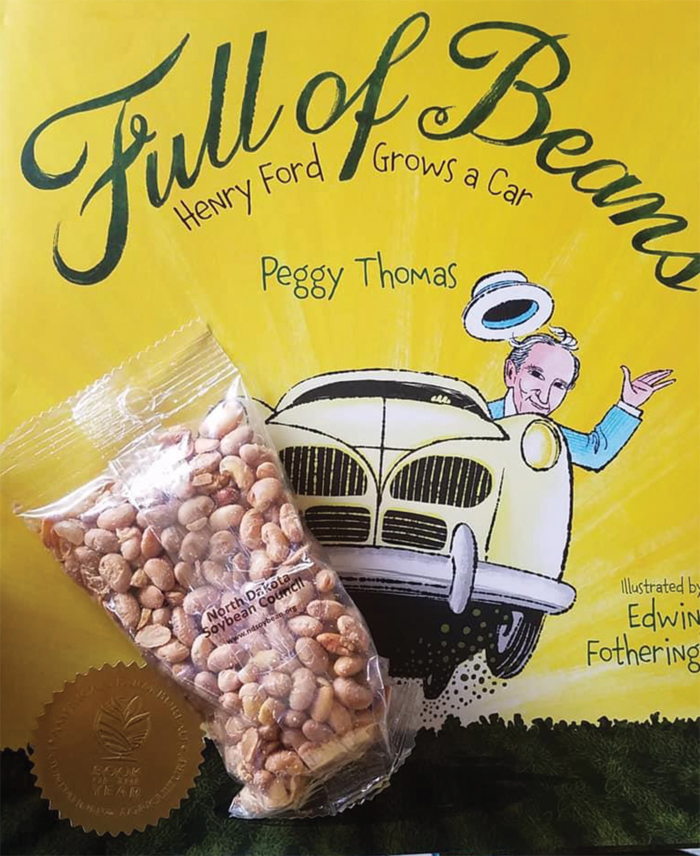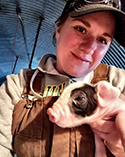This article first appeared on OYT on April 1, 2020
by Heather Lang
Soybeans, cars, and vegetable oils: what do they all have in common? If you answered soybeans, you’d be correct. Not only can our cars now drive on soybeans, biofuels and biodiesel, but did you know that Henry Ford made an entire car out of soybeans and was the first to use soybean paint on cars?! He sure did.
Earlier [last] year the American Farm Bureau Foundation for Agriculture released its 13th book of the year: “Full of Beans: Henry Ford grows a car.” The book describes Henry Ford’s drive to incorporate soybeans into every part of his life. This is one of the books I was sharing in classrooms until the COVID-19 lockdown. The kids were completely enjoying it and were flabbergasted to find out all the incredible things soybeans have been used for. And, thanks to the N.D. Soybean Council, each child went home with a healthy snack of soynuts.

Don Scott, Director of Sustainability for the National Biodiesel Board, recently explained to me a little a bit about the miracle soybean. “Soybeans are growing in popularity, because they are the most efficient way to produce protein for our food supply. Soybeans produce more protein per acre than any other crop and with a superior nutritional profile.”
I have heard that soybeans grow best in soils similar to corn land and in many cases, they are grown in rotation with corn or wheat to break insect, weed and disease cycles.
“Soybeans are naturally suited to produce protein, because they fix their own nitrogen in the soil," Scott explained. "Nitrogen is required to produce protein. Soybeans can use nitrogen from the air and rhizobia bacteria on their roots to make their own nitrogen fertilizer in a completely natural symbiosis. When planted in rotation with corn, soybeans reduce the cost of nitrogen fertilizer."
"Corn also produces some protein and needs an outside source of nitrogen” he continued. “The United States has been a leading producer and exporter of soybeans for many years. However, competition has been growing from Brazil and Argentina in recent years and approximately half of U.S. soybeans are exported as whole beans along with nearly one-third previously going to China, specifically.”
Soybeans, pigs, cars and vegetable oil: what do they all have in common? You guessed it – soybeans! We rely on soybean farmers on our farm. The soybean meal is a main component of our pigs’ feed. As Don stated during our call, “Soy protein is a great nutritional value for poultry, pork, and dairy production.” I wondered if he could describe to me what other benefits soybeans could provide for both humans and livestock?
“Protein is vital to the human diet and should make up 30% of the human diet for proper nutritional health. In order to grow enough protein for the human food supply, the crops that farmers harvest coincidentally contain more fats and carbohydrates than we can possibly eat. In order to make protein production economical to feed the entire world, we must find commercial uses to sell the excess fats,” Scott said. “Protein would be too expensive if we could not sell the fat byproducts for industrial uses. Fats include vegetable oils like soybean oil, as well as animal fats. Approximately half of the biodiesel made in the United States is made from excess soybean oil. The rest is made from used cooking oil, animal fats, or other vegegetable oils like canola and corn oil.”
Scott also said the corn oil used for biodiesel is a special inedible byproduct of ethanol manufacturing. The protein from corn is also used for livestock feed. The corn starch is used to make ethanol, and the left-over corn oil can be used to make biodiesel.
In the pork industry we like to use the saying, “We use everything but the oink.” The same can be said reasoning can be used for many agriculture products, because agriculture is not just farming and ranching. It provides us with so much more than “just” meat. In fact, everyone NEEDS agriculture to stay alive, healthy, clothed, and fueled. An article in Farm Flavor states, “Agriculture is a vital economic force in North Dakota. About 90 percent of the state’s land is used for agriculture, totaling 40 million acres devoted to farming and ranching. Additionally, 24 percent of the state’s population is employed in the agricultural sector alone.” That’s HUGE!
Some other great byproducts we get from soybeans that you might not realize include mayonnaise, salad dressings, crackers, cookies and pies. Construction materials like particle board, laminated plywood, and many lubricants are soy-based.
Parents can feel safe allowing their kids to use soy-based crayons since they are nontoxic and enjoy burning soy candles because they tend to burn longer with less soot and smoke. The classes I taught about soybeans had a blast making this fun, easy, 3-ingredient recipe for soy plastic that is made from common ingredients found in your pantry.
Make Your own Soybean Plastic
Ingredients
1 Tbsp cornstarch
1 Tbsp Water
1/8 tsp soybean oil (vegetable oil)
1 wide mouth glass jar or cup
Instructions
Mix cornstarch, water, and soybean oil in glass container. Microwave the mixture for twenty seconds. Carefully take the container out of microwave (it will be hot). Let cool, then scoop out your creation. The heat will have allowed the starch in the cornstarch to bind with the soybean oil to form plastic just like Henry Ford did for his soybean plastic car.
 Heather Lang is a mom and farmer from Sterling, N.D. She is the Distrtict 7 representative on the NDFB Promotion and Education Committee and also serves on the American Farm Bureau Federation P&E Committee.
Heather Lang is a mom and farmer from Sterling, N.D. She is the Distrtict 7 representative on the NDFB Promotion and Education Committee and also serves on the American Farm Bureau Federation P&E Committee.
